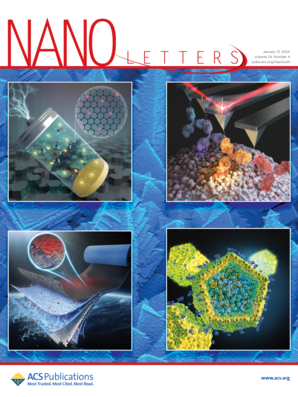What Is the Role of a Magnetic Mo Antisite Defect on Carrier Relaxation and Spin Dynamics in 2-D MoS2?
IF 9.6
1区 材料科学
Q1 CHEMISTRY, MULTIDISCIPLINARY
引用次数: 0
Abstract
Antisite defects significantly influence the dynamic properties of monolayer MoS2, yet the carrier relaxation and spin dynamics in spin-polarized Mo antisite-defective MoS2 remain unclear. Understanding these processes is crucial for advancing optoelectronic, spintronic, and valleytronic devices. Here, we employ first-principles calculations and ab initio nonadiabatic molecular dynamics with spin–orbit coupling (SOC) to explore carrier relaxation and spin dynamics in MoS2 with a Mo antisite defect. This defect alters the material’s magnetic properties, leading to distinct relaxation behaviors: electron relaxation is slower than hole relaxation, and charge carriers in different spin channels exhibit varied dynamics. These differences arise from variations in electron–phonon coupling, SOC strength, and phonon mode activation. Our findings provide key insights into charge and spin dynamics in MoS2 with magnetic defects and suggest strategies to enhance the performance of next-generation optoelectronic, spintronic, and valleytronic devices.

磁性Mo反位缺陷对二维MoS2中载流子弛豫和自旋动力学的作用?
反位缺陷显著影响单层MoS2的动力学性质,但自旋极化Mo反位缺陷MoS2的载流子弛豫和自旋动力学尚不清楚。了解这些过程对于推进光电、自旋电子和谷电子器件至关重要。本文采用第一性原理计算和自旋-轨道耦合(SOC)的从头算非绝热分子动力学方法来研究具有Mo反位缺陷的MoS2中的载流子弛豫和自旋动力学。这种缺陷改变了材料的磁性,导致了不同的弛豫行为:电子弛豫比空穴弛豫慢,不同自旋通道中的载流子表现出不同的动力学。这些差异是由电子-声子耦合、SOC强度和声子模式激活的变化引起的。我们的研究结果为具有磁性缺陷的MoS2的电荷和自旋动力学提供了关键见解,并为提高下一代光电、自旋电子和谷电子器件的性能提供了策略。
本文章由计算机程序翻译,如有差异,请以英文原文为准。
求助全文
约1分钟内获得全文
求助全文
来源期刊

Nano Letters
工程技术-材料科学:综合
CiteScore
16.80
自引率
2.80%
发文量
1182
审稿时长
1.4 months
期刊介绍:
Nano Letters serves as a dynamic platform for promptly disseminating original results in fundamental, applied, and emerging research across all facets of nanoscience and nanotechnology. A pivotal criterion for inclusion within Nano Letters is the convergence of at least two different areas or disciplines, ensuring a rich interdisciplinary scope. The journal is dedicated to fostering exploration in diverse areas, including:
- Experimental and theoretical findings on physical, chemical, and biological phenomena at the nanoscale
- Synthesis, characterization, and processing of organic, inorganic, polymer, and hybrid nanomaterials through physical, chemical, and biological methodologies
- Modeling and simulation of synthetic, assembly, and interaction processes
- Realization of integrated nanostructures and nano-engineered devices exhibiting advanced performance
- Applications of nanoscale materials in living and environmental systems
Nano Letters is committed to advancing and showcasing groundbreaking research that intersects various domains, fostering innovation and collaboration in the ever-evolving field of nanoscience and nanotechnology.
 求助内容:
求助内容: 应助结果提醒方式:
应助结果提醒方式:


